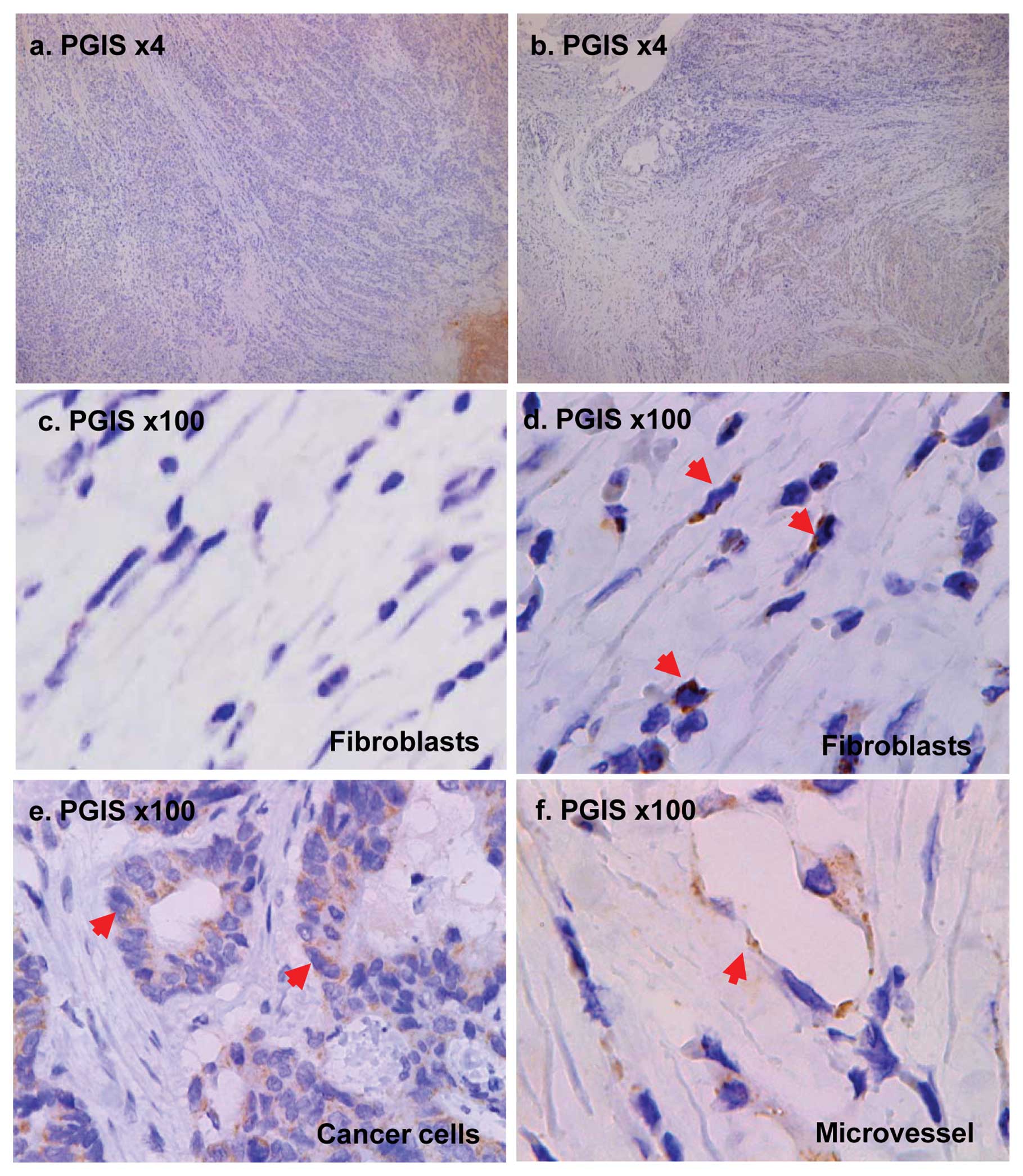|
1
|
Nakagawa H, Liyanarachchi S, Davuluri RV,
Auer H, Martin EW Jr, de la Chapelle A and Frankel WL: Role of
cancer-associated stromal fibroblasts in metastatic colon cancer to
the liver and their expression profiles. Oncogene. 23:7366–7377.
2004. View Article : Google Scholar : PubMed/NCBI
|
|
2
|
Fidler IJ: The pathogenesis of cancer
metastasis: the ‘seed and soil’ hypothesis revisited. Nat Rev
Cancer. 3:453–458. 2003.
|
|
3
|
Cutler NS, Graves-Deal R, LaFleur BJ, Gao
Z, Boman BM, Whitehead RH, Terry E, Morrow JD and Coffey RJ:
Stromal production of prostacyclin confers an antiapoptotic effect
to colonic epithelial cells. Cancer Res. 63:1748–1751.
2003.PubMed/NCBI
|
|
4
|
Ingerman-Wojenski C, Silver MJ, Smith JB
and Macarak E: Bovine endothelial cells in culture produce
thromboxane as well as prostacyclin. J Clin Invest. 67:1292–1296.
1981. View Article : Google Scholar : PubMed/NCBI
|
|
5
|
Moncada S, Gryglewski R, Bunting S and
Vane JR: An enzyme isolated from arteries transforms prostaglandin
endoperoxides to an unstable substance that inhibits platelet
aggregation. Nature. 263:663–665. 1976. View Article : Google Scholar
|
|
6
|
Moncada S, Herman AG, Higgs EA and Vane
JR: Differential formation of prostacyclin (PGX or PGI2) by layers
of the arterial wall. An explanation for the anti-thrombotic
properties of vascular endothelium. Thromb Res. 11:323–344. 1977.
View Article : Google Scholar : PubMed/NCBI
|
|
7
|
Ullrich V, Castle L and Weber P: Spectral
evidence for the cytochrome P450 nature of prostacyclin synthetase.
Biochem Pharmacol. 30:2033–2036. 1981. View Article : Google Scholar : PubMed/NCBI
|
|
8
|
Weksler BB, Ley CW and Jaffe EA:
Stimulation of endothelial cell prostacyclin production by
thrombin, trypsin, and the ionophore A 23187. J Clin Invest.
62:923–930. 1978. View Article : Google Scholar : PubMed/NCBI
|
|
9
|
Yokoyama C, Yabuki T, Shimonishi M, Wada
M, Hatae T, Ohkawara S, Takeda J, Kinoshita T, Okabe M and Tanabe
T: Prostacyclin-deficient mice develop ischemic renal disorders,
including nephrosclerosis and renal infarction. Circulation.
106:2397–2403. 2002. View Article : Google Scholar
|
|
10
|
Gupta RA, Tan J, Krause WF, Geraci MW,
Willson TM, Dey SK and DuBois RN: Prostacyclin-mediated activation
of peroxisome proliferator-activated receptor delta in colorectal
cancer. Proc Natl Acad Sci USA. 97:13275–13280. 2000. View Article : Google Scholar : PubMed/NCBI
|
|
11
|
Wu KK and Liou JY: Cyclooxygenase
inhibitors induce colon cancer cell apoptosis via PPARdelta →
14-3-3epsilon pathway. Methods Mol Biol. 512:295–307.
2009.PubMed/NCBI
|
|
12
|
Arany Z, Foo SY, Ma Y, Ruas JL,
Bommi-Reddy A, Girnun G, Cooper M, Laznik D, Chinsomboon J,
Rangwala SM, Baek KH, Rosenzweig A and Spiegelman BM:
HIF-independent regulation of VEGF and angiogenesis by the
transcriptional coactivator PGC-1alpha. Nature. 451:1008–1012.
2008. View Article : Google Scholar : PubMed/NCBI
|
|
13
|
Mizukami Y, Li J, Zhang X, Zimmer MA,
Iliopoulos O and Chung DC: Hypoxia-inducible factor-1-independent
regulation of vascular endothelial growth factor by hypoxia in
colon cancer. Cancer Res. 64:1765–1772. 2004. View Article : Google Scholar : PubMed/NCBI
|
|
14
|
Wang J, Hasui K, Jia X, Matsuyama T and
Eizuru Y: Possible role for external environmental stimuli in
nasopharyngeal NK/T-cell lymphomas in the northeast of China with
EBV infection-related autophagic cell death: a pathoepidemiological
analysis. J Clin Exp Hematop. 49:97–108. 2009. View Article : Google Scholar
|
|
15
|
Nakajima Y, Gotanda T, Uchimiya H,
Furukawa T, Haraguchi M, Ikeda R, Sumizawa T, Yoshida H and Akiyama
S: Inhibition of metastasis of tumor cells overexpressing thymidine
phosphorylase by 2-deoxy-L-ribose. Cancer Res. 64:1794–1801. 2004.
View Article : Google Scholar : PubMed/NCBI
|
|
16
|
Buchanan FG, Chang W, Sheng H, Shao J,
Morrow JD and DuBois RN: Up-regulation of the enzymes involved in
prostacyclin synthesis via Ras induces vascular endothelial growth
factor. Gastroenterology. 127:1391–1400. 2004. View Article : Google Scholar : PubMed/NCBI
|
|
17
|
Kamio K, Sato T, Liu X, Sugiura H, Togo S,
Kobayashi T, Kawasaki S, Wang X, Mao L, Ahn Y, Holz O, Magnussen H
and Rennard SI: Prostacyclin analogs stimulate VEGF production from
human lung fibroblasts in culture. Am J Physiol Lung Cell Mol
Physiol. 294:L1226–L1232. 2008. View Article : Google Scholar : PubMed/NCBI
|
|
18
|
Tong BJ, Tan J, Tajeda L, Das SK, Chapman
JA, DuBois RN and Dey SK: Heightened expression of cyclooxygenase-2
and peroxisome proliferator-activated receptor-delta in human
endometrial adenocarcinoma. Neoplasia. 2:483–490. 2000. View Article : Google Scholar
|
|
19
|
Piqueras L, Reynolds AR, Hodivala-Dilke
KM, Alfranca A, Redondo JM, Hatae T, Tanabe T, Warner TD and
Bishop-Bailey D: Activation of PPARbeta/delta induces endothelial
cell proliferation and angiogenesis. Arterioscler Thromb Vasc Biol.
27:63–69. 2007. View Article : Google Scholar : PubMed/NCBI
|
|
20
|
Moreira IS, Fernandes PA and Ramos MJ:
Vascular endothelial growth factor (VEGF) inhibition - a critical
review. Anticancer Agents Med Chem. 7:223–245. 2007. View Article : Google Scholar : PubMed/NCBI
|
|
21
|
Wang D, Wang H, Guo Y, Ning W, Katkuri S,
Wahli W, Desvergne B, Dey SK and DuBois RN: Crosstalk between
peroxisome proliferator-activated receptor delta and VEGF
stimulates cancer progression. Proc Natl Acad Sci USA.
103:19069–19074. 2006. View Article : Google Scholar : PubMed/NCBI
|
|
22
|
Fukumoto K, Yano Y, Virgona N, Hagiwara H,
Sato H, Senba H, Suzuki K, Asano R, Yamada K and Yano T: Peroxisome
proliferator-activated receptor delta as a molecular target to
regulate lung cancer cell growth. FEBS Lett. 579:3829–3836. 2005.
View Article : Google Scholar : PubMed/NCBI
|
|
23
|
Camacho M, Rodríguez C, Guadall A, Alcolea
S, Orriols M, Escudero JR, Martínez-González J and Vila L: Hypoxia
upregulates PGI-synthase and increases PGI release in human
vascular cells exposed to inflammatory stimuli. J Lipid Res.
52:720–731. 2011. View Article : Google Scholar : PubMed/NCBI
|
















